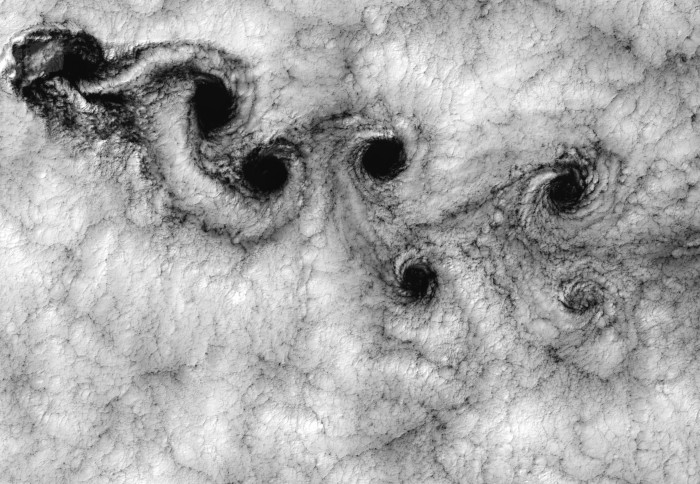
Oscillating vortex street

Aeronautics researchers have simulated imprints from obstacles of various size on wind flow to further understand physics of multiscale interactions.
Researchers, within the Department of Aeronautics, have simulated how wakes of individual wind turbine components interact to form the wake of a combined system, as well as how such combined systems interact with one another.
As an example, wind blowing through a city will encounter different buildings of various heights, everything from small houses to skyscrapers. Each structure leaves an impression on the flow, thus producing a disturbance in the atmosphere – a turbulent wake.
Such wakes then interact with one another to produce a combined, multiscale flow.
A team of researchers, led by Dr Oliver Buxton, have simulated multiscale flows to understand the flow physics of these interactions.
Wake imprint
The most simple type of object that produces a turbulent wake with a well-studied imprint on the flow is a circular cylinder. The particular imprint left in a cylinder wake is the oscillating vortex street.
To create a simple multiscale flow that yields these multiscale physics the team used a combination of a large cylinder (termed as the main cylinder), and a small cylinder with a diameter ten times smaller than the main cylinder, a so-called control rod.
The team observed that the flow not only produced oscillating vortex streets at the two frequencies associated to the main cylinder and control rod, but also identified secondary frequencies as the flow maneuvered past the cylinders.
Kinetic energy exchange
The researchers observed energy being exchanged between the time-averaged flow and the concurrent wakes and used this to explain the overall drag force acting on the combined system. In addition, they were able to identify the energy source for the secondary frequencies which had been previously unexplained.
These kinetic energy exchanges were identified as being vital in determining the development of the turbulent wake of the combined multiscale system.
The team look to perform the same analysis on the wake formed present during flow through a wind turbine. First author and PhD candidate Neelakash Biswas said: “These new findings on energy exchanges in a multiscale flow are vital as they can serve as a foundation to understand more complex multiscale flows such as the flow past a wind turbine. These multiscale interactions have often been a neglected aspect of the modelling of wind turbine wakes."
Wind farm efficiency
Similar to the combination of cylinders, as wind travels through wind turbines, it interacts with different-sized parts of the wind turbine (e.g. tower, nacelle, blades etc.), causing a multiscale flow, as can be seen from the below figure obtained from an ongoing experimental campaign of the team.
Since wind turbines are placed within the wake of an upstream machine in a wind farm, identifying how multiscale interactions influence the development of a wind turbine wake will be fundamental for optimisation of configuration in future wind farm design for increased efficiency and power yield.
In noting future work, Dr Oliver Buxton, Reader in Experimental Fluid Mechanics and EPSRC fellow, said: “In the current study we have made fantastic progress in understanding the multiscale physics of turbulent wakes. Now we must apply this to flows through more representative wind farms where the rotation of the blades is important. Work is already underway and we hope that we will have a much better understanding of wind-turbine wakes in a few years' time.”
This research if funded by a five-year EPSRC fellowship (£1.57million) awarded to Dr Oliver Buxton.
‘Energy exchanges in the flow past a cylinder with a leeward control rod’ by Neelakash Biswas, Murilo M. Cicolin and Dr Oliver Buxton is published in the Journal of Fluid Mechanics.
Article text (excluding photos or graphics) © Imperial College London.
Photos and graphics subject to third party copyright used with permission or © Imperial College London.
Reporter

Ayesha Khan
Department of Aeronautics



